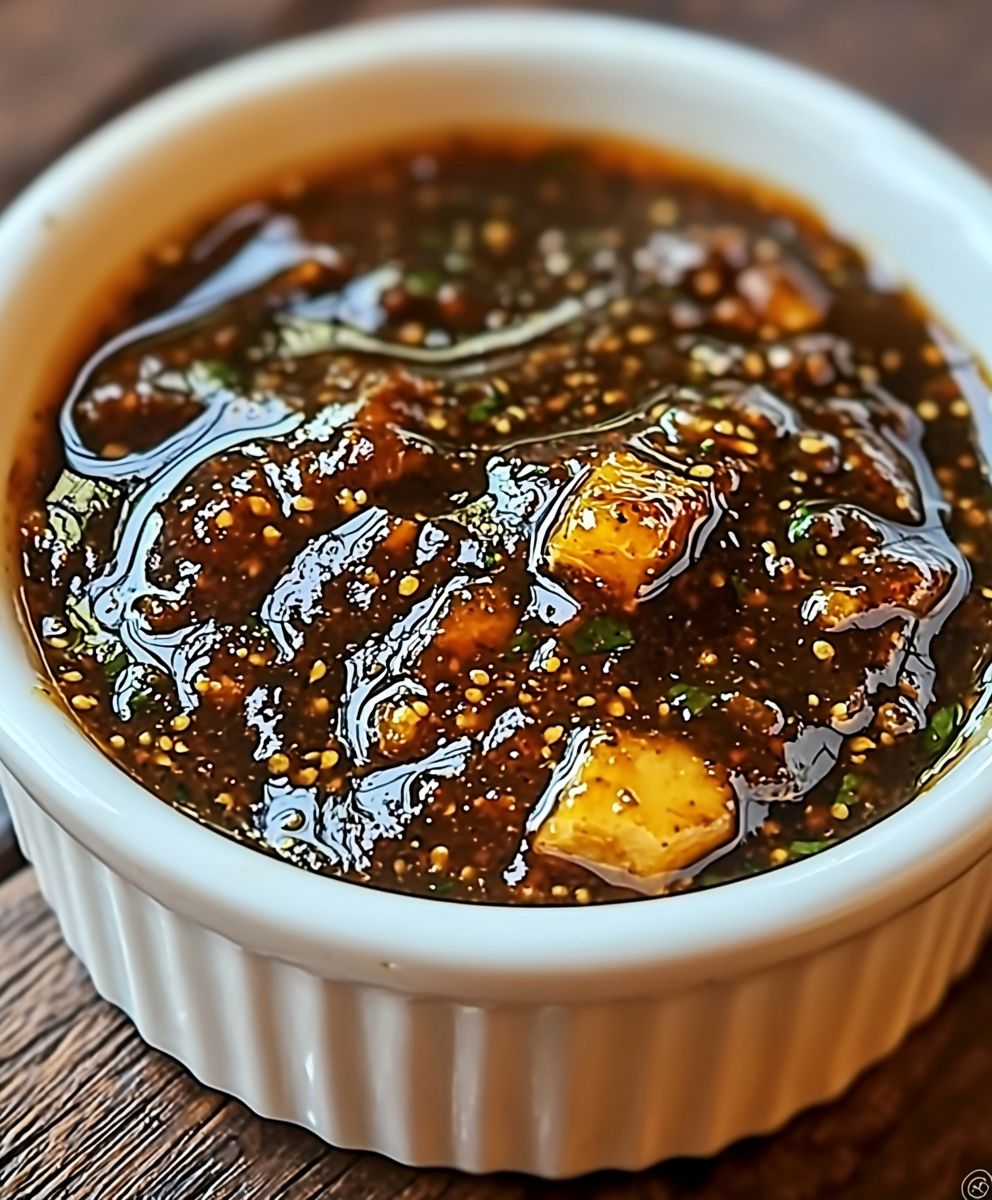Jamaican Jerk Sauce: Prepare to ignite your taste buds with a flavor explosion! Imagine succulent, perfectly grilled chicken, pork, or even vegetables, infused with a smoky, spicy, and utterly irresistible marinade. That’s the magic of authentic Jamaican Jerk, and it all starts with the sauce.
Jerk isn’t just a recipe; it’s a culinary legacy deeply rooted in Jamaican history. Originating with the Maroons, escaped slaves who ingeniously preserved and seasoned wild game in the hills of Jamaica, the technique evolved over centuries. They used native spices and smoking methods to create a unique flavor profile that’s now celebrated worldwide. The word “jerk” itself is believed to derive from the Spanish word “charqui,” meaning dried meat, reflecting the preservation aspect of the original method.
What makes Jamaican Jerk Sauce so universally loved? It’s the perfect balance of heat, sweetness, and savory notes. The fiery Scotch bonnet peppers, combined with aromatic spices like allspice, thyme, and ginger, create a complex and unforgettable taste sensation. People adore the versatility of jerk; it can be used as a marinade, a rub, or even a dipping sauce. Plus, it’s surprisingly easy to make at home, allowing you to bring the vibrant flavors of the Caribbean to your own kitchen. So, let’s dive in and discover how to create the perfect homemade Jamaican Jerk Sauce!
Ingredients:
- 2 Scotch bonnet peppers, stemmed and seeded (use gloves!)
- 1 large onion, roughly chopped
- 4-6 scallions, roughly chopped
- 6 cloves garlic, peeled
- 1 inch piece of ginger, peeled and roughly chopped
- 1 tablespoon ground allspice
- 1 teaspoon ground cinnamon
- 1/2 teaspoon ground nutmeg
- 1/2 teaspoon ground cloves
- 1 teaspoon dried thyme
- 1 teaspoon dried rosemary
- 1 teaspoon dried sage
- 1/4 cup soy sauce
- 1/4 cup apple cider vinegar
- 2 tablespoons brown sugar, packed
- 2 tablespoons vegetable oil
- 1 tablespoon lime juice
- 1 teaspoon black pepper
- 1/2 teaspoon salt, or to taste
- 1/4 cup water, or as needed for consistency
Preparing the Jerk Sauce:
- Handle the Scotch Bonnets with Care: This is crucial! Put on gloves before you even think about touching those Scotch bonnet peppers. Trust me, you don’t want that burn on your skin, and definitely not in your eyes. Remove the stems and carefully scrape out the seeds. The seeds are where a lot of the heat resides, so removing them will help control the overall spiciness of the sauce. If you’re particularly sensitive to heat, you can remove the membranes as well.
- Combine the Aromatics: In a food processor or blender, combine the chopped onion, scallions, garlic, and ginger. These ingredients form the aromatic base of the jerk sauce, providing a complex and layered flavor profile. Process until finely chopped. You want a relatively smooth mixture, but don’t over-process it into a complete puree just yet.
- Add the Spices: Now, add all the ground spices allspice, cinnamon, nutmeg, and cloves to the food processor. Also, add the dried thyme, rosemary, and sage. These spices are what give jerk its signature warm and earthy flavor. Pulse the mixture a few times to combine the spices with the aromatics. This ensures that the spices are evenly distributed throughout the sauce.
- Incorporate the Wet Ingredients: Pour in the soy sauce, apple cider vinegar, brown sugar, vegetable oil, and lime juice. The soy sauce adds umami and saltiness, the apple cider vinegar provides tanginess, the brown sugar contributes sweetness and depth, the vegetable oil helps to emulsify the sauce, and the lime juice adds a bright, citrusy note.
- Blend to a Smooth Paste: Now it’s time to blend everything together into a smooth paste. Process the mixture until it’s as smooth as possible. You may need to stop the food processor a few times to scrape down the sides with a spatula to ensure that all the ingredients are fully incorporated.
- Adjust the Consistency: If the sauce is too thick, add water, one tablespoon at a time, until it reaches your desired consistency. I prefer a sauce that’s thick enough to coat the meat but not so thick that it’s difficult to spread.
- Season to Perfection: Finally, season the jerk sauce with black pepper and salt. Start with the recommended amounts and then taste the sauce. Adjust the seasoning as needed to suit your personal preferences. Remember that the sauce will intensify in flavor as it sits, so don’t over-salt it at this stage.
Using the Jerk Sauce:
- Marinating the Meat: The key to authentic jerk flavor is marinating the meat for an extended period. For chicken or pork, I recommend marinating for at least 4 hours, or preferably overnight, in the refrigerator. This allows the flavors of the jerk sauce to penetrate deep into the meat, resulting in a more flavorful and tender final product. For tougher cuts of meat, like goat or beef, you may want to marinate for even longer, up to 24 hours.
- Applying the Sauce: Generously coat the meat with the jerk sauce, making sure to get it into all the nooks and crannies. Use your hands to massage the sauce into the meat, ensuring that it’s evenly distributed. This will help to create a flavorful crust during cooking.
- Grilling or Smoking: Traditionally, jerk is cooked over pimento wood, which imparts a unique smoky flavor. However, if you don’t have access to pimento wood, you can use charcoal or gas grill. For the best results, cook the meat over indirect heat, which will help to prevent it from burning. If you’re using a charcoal grill, you can add wood chips to the coals to create a smoky flavor.
- Oven Baking: If you don’t have a grill, you can also bake the meat in the oven. Preheat the oven to 350°F (175°C) and bake the meat until it’s cooked through. The cooking time will vary depending on the type and size of the meat.
- Slow Cooking: Another great option is to slow cook the meat in a slow cooker or Dutch oven. This will result in a very tender and flavorful final product. Cook on low for 6-8 hours, or until the meat is easily shredded with a fork.
- Serving Suggestions: Jerk is typically served with rice and peas (coconut rice and kidney beans), coleslaw, and fried plantains. It’s also delicious in sandwiches, tacos, and salads.
Adjusting the Heat Level:
- Reducing the Heat: If you’re sensitive to heat, you can reduce the amount of Scotch bonnet peppers in the recipe. You can also remove the seeds and membranes from the peppers, as this is where a lot of the heat resides. Another option is to substitute a milder pepper, such as a habanero or a jalapeño, for the Scotch bonnet.
- Increasing the Heat: If you like your jerk sauce extra spicy, you can add more Scotch bonnet peppers to the recipe. You can also leave the seeds and membranes in the peppers. Another option is to add a pinch of cayenne pepper or a few drops of hot sauce to the sauce.
Storage Instructions:
- Refrigerating: The jerk sauce can be stored in an airtight container in the refrigerator for up to 2 weeks. The flavors will actually meld and improve over time.
- Freezing: The jerk sauce can also be frozen for up to 3 months. To freeze, pour the sauce into freezer-safe containers or zip-top bags. Be sure to leave some headspace in the containers, as the sauce will expand as it freezes. When you’re ready to use the sauce, thaw it in the refrigerator overnight.
Tips and Tricks:
- Use Fresh Ingredients: For the best flavor, use fresh ingredients whenever possible. Fresh Scotch bonnet peppers, onions, scallions, garlic, and ginger will make a big difference in the taste of the sauce.
- Toast the Spices: Toasting the spices before adding them to the sauce will enhance their flavor. To toast the spices, heat them in a dry skillet over medium heat for a few minutes, until they become fragrant. Be careful not to burn the spices.
- Let the Sauce Sit: The jerk sauce will taste even better if you let it sit for a few hours, or even overnight, before using it. This will allow the flavors to meld and deepen.
- Adjust the Sweetness: If you prefer a sweeter jerk sauce, you can add more brown sugar to the recipe. You can also add a touch of honey or maple syrup.
- Experiment with Flavors: Don’t be afraid to experiment with different flavors and ingredients. You can add other spices, such as cumin, coriander, or smoked paprika, to the sauce. You can also add other ingredients, such as mango, pineapple, or coconut milk.
Serving Suggestions:
- Jerk Chicken: The classic! Marinate chicken pieces in the jerk sauce and grill, bake, or smoke until cooked through.
- Jerk Pork: Similar to jerk chicken, but with pork. Shoulder or tenderloin work well.
- Jerk Fish: Marinate firm white fish like snapper or mahi-mahi in the jerk sauce and grill or bake.
- Jerk Shrimp: Toss shrimp with the jerk sauce and grill or sauté.
- Jerk Vegetables: Toss vegetables like bell peppers, onions, and zucchini with the jerk sauce and grill or roast.
- Jerk Tacos: Use jerk chicken, pork, or vegetables as a filling for tacos. Top with your favorite taco toppings.
- Jerk Bowls: Create a bowl with rice, beans, jerk protein, and your favorite toppings.
- Jerk Pizza:

Conclusion:
This Jamaican Jerk Sauce recipe isn’t just another condiment; it’s a passport to flavor town! Seriously, if you’re looking to inject some serious zing and authentic Caribbean vibes into your cooking, you absolutely have to give this a try. The complex blend of spices, the fiery scotch bonnet peppers (use with caution!), and the subtle sweetness create a symphony of taste that will have you craving more. I’ve been making this sauce for years, and it’s consistently a crowd-pleaser. Trust me, once you taste the difference between store-bought and homemade, you’ll never go back. But why is this recipe a must-try? Beyond the incredible flavor, it’s surprisingly versatile. While traditionally used on chicken and pork, don’t limit yourself! I’ve slathered it on grilled shrimp with fantastic results, used it as a marinade for tofu (seriously!), and even added a spoonful to my scrambled eggs for a spicy breakfast kick. The possibilities are truly endless. Speaking of versatility, let’s talk serving suggestions and variations. For a classic Jamaican experience, marinate chicken pieces in the sauce for at least 4 hours (or overnight for maximum flavor) and then grill or bake until cooked through. Serve with rice and peas (coconut rice and kidney beans) and some steamed vegetables for a complete and satisfying meal. If you’re feeling adventurous, try using the sauce as a glaze for roasted vegetables like sweet potatoes or butternut squash. The sweetness of the vegetables pairs beautifully with the spicy jerk flavors. Want to tone down the heat? Remove the seeds and membranes from the scotch bonnet peppers before blending, or substitute them with milder habaneros or even jalapeños. For a sweeter sauce, add a touch more brown sugar or a splash of pineapple juice. If you prefer a smoother consistency, strain the sauce through a fine-mesh sieve after blending. And for a richer flavor, try toasting the whole spices (like allspice berries and cloves) in a dry pan for a few minutes before grinding them. This will really bring out their aromatic oils. I’m so confident that you’ll love this Jamaican Jerk Sauce recipe that I’m practically begging you to try it! It’s a relatively simple recipe to follow, and the payoff in terms of flavor is immense. Plus, making your own sauce allows you to control the ingredients and customize it to your exact preferences. So, what are you waiting for? Gather your spices, grab some scotch bonnets (handle with care!), and get ready to embark on a culinary adventure. Once you’ve made your own batch of this incredible sauce, I’d absolutely love to hear about your experience. Did you try it on chicken, pork, or something completely different? Did you adjust the spice level or add any unique ingredients? Share your photos and stories in the comments below! I’m always looking for new and exciting ways to use this versatile sauce, and I can’t wait to see what you come up with. Happy cooking! And remember, a little jerk sauce goes a long way in adding a big punch of flavor to any dish. Don’t be afraid to experiment and have fun with it! Print
Jamaican Jerk Sauce: The Ultimate Guide to Flavor & Authenticity
- Total Time: 15 minutes
- Yield: 1 1/2 cups 1x
Description
Fiery Jamaican Jerk Sauce with Scotch bonnets, warm spices, and savory aromatics. Great for marinating meats and vegetables.
Ingredients
- 2 Scotch bonnet peppers, stemmed and seeded (use gloves!)
- 1 large onion, roughly chopped
- 4–6 scallions, roughly chopped
- 6 cloves garlic, peeled
- 1 inch piece of ginger, peeled and roughly chopped
- 1 tablespoon ground allspice
- 1 teaspoon ground cinnamon
- 1/2 teaspoon ground nutmeg
- 1/2 teaspoon ground cloves
- 1 teaspoon dried thyme
- 1 teaspoon dried rosemary
- 1 teaspoon dried sage
- 1/4 cup soy sauce
- 1/4 cup apple cider vinegar
- 2 tablespoons brown sugar, packed
- 2 tablespoons vegetable oil
- 1 tablespoon lime juice
- 1 teaspoon black pepper
- 1/2 teaspoon salt, or to taste
- 1/4 cup water, or as needed for consistency
Instructions
- Handle the Scotch Bonnets with Care: Put on gloves before handling Scotch bonnet peppers. Remove the stems and carefully scrape out the seeds (and membranes, if desired).
- Combine the Aromatics: In a food processor or blender, combine the chopped onion, scallions, garlic, and ginger. Process until finely chopped.
- Add the Spices: Add allspice, cinnamon, nutmeg, cloves, thyme, rosemary, and sage to the food processor. Pulse to combine.
- Incorporate the Wet Ingredients: Pour in soy sauce, apple cider vinegar, brown sugar, vegetable oil, and lime juice.
- Blend to a Smooth Paste: Process until smooth, scraping down the sides as needed.
- Adjust the Consistency: If the sauce is too thick, add water, one tablespoon at a time, until it reaches your desired consistency.
- Season to Perfection: Season with black pepper and salt to taste.
Notes
- Heat Level: Adjust the number of Scotch bonnet peppers or remove seeds/membranes to control the spiciness.
- Marinating: Marinate meat for at least 4 hours, or preferably overnight, for best flavor.
- Cooking: Grill, bake, or slow cook marinated meat.
- Storage: Store in an airtight container in the refrigerator for up to 2 weeks or freeze for up to 3 months.
- Serving Suggestions: Serve with rice and peas, coleslaw, fried plantains, or use in sandwiches, tacos, and salads.
- Tips and Tricks: Use fresh ingredients, toast the spices, let the sauce sit, adjust the sweetness, and experiment with flavors.
- Prep Time: 15 minutes
- Cook Time: 0 minutes




